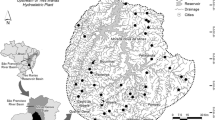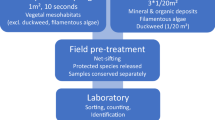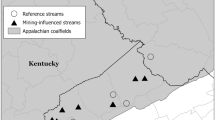Abstract
Aquatic invertebrates are excellent indicators of ecosystem quality; however, choosing a sampling method can be difficult. Each method and associated protocol has advantages and disadvantages, and finding the approach that minimizes biases yet fulfills management objectives is crucial. To test the effects of both sampling methods and sample handling—i.e., to composite samples or leave them as replicates—we collected aquatic invertebrates from the Niobrara River at Agate Fossil Beds National Monument, Nebraska, using three methods and two sample handling protocols. We compared aquatic invertebrate assemblages collected with a Hester-Dendy multi-plate sampler, Hess sampler, and a D-frame dipnet. We calculated six common bioassessment metrics from composite (combined) and replicate (separate) samples. Hess samples contained the highest taxonomic richness (capturing 77% of all taxa observed) and dipnet samples the least (47%). Hester-Dendy samples had the greatest proportion of Ephemeroptera, and Ephemeroptera, Plecoptera, and Trichoptera (EPT). Dipnet samples had the lowest evenness values. In terms of sample handling, composite samples had inflated richness, diversity, and evenness compared with replicate samples, but bioassessment metrics calculated from proportions or averages (i.e., Hilsenhoff’s Biotic Index and the proportion of EPT taxa) did not differ between them. The proportion of invertebrate groups from composite samples were not statistically different among sampling methods, but several groups differed between replicate samples collected by different methods. Ultimately, we recommend collecting replicate samples with a Hess sampler when the goal of the study is to detect ecosystem change, among locations or differences in variables of interest.





Similar content being viewed by others
References
Barbour, M. T., Gerritsen, J., Snyder, B. D., & Stribling, J. B. (1999). Rapid bioassessment protocols for use in streams and wadeable rivers: Periphyton, benthic macroinvertebrates and fish. Washington, D.C.: U.S. Environmental Protection Agency.
Bates, D., & Maechler, M. (2013). Matrix: sparse and dense matrix classes and methods. R package version 1.0-12.
Battle, J. M., Jackson, J. K., & Sweeney, B. W. (2007). Mesh size affects macroinvertebrate descriptions in large rivers: Examples from the Savannah and Mississippi Rivers. Hydrobiologia, 592, 329–343. https://doi.org/10.1007/s10750-007-0771-x.
Bouchard, R. W., Genet, J. A., & Chirhart, J. W. (2014). Does supplementing dipnet samples with activity traps improve the ability to assess the biological integrity of macroinvertebrate communities in depressional wetlands? Wetlands, 34(4), 699–711. https://doi.org/10.1007/s13157-014-0535-0.
Bradley, D. C., & Ormerod, S. J. (2002). Evaluating the precision of kick-sampling in upland streams for assessments of long-term change: The effects of sampling effort, habitat and rarity. Archiv Fur Hydrobiologie, 155(2), 199–221.
Buss, D. F., & Borges, E. L. (2008). Application of Rapid Bioassessment Protocols (RBP) for benthic macroinvertebrates in Brazil: Comparison between sampling techniques and mesh sizes. Neotropical Entomology, 37(3), 288–295. https://doi.org/10.1590/s1519-566x2008000300007.
Cairns, J., & Pratt, J. R. (1993). A history of biological monitoring using benthic macroinvertebrates. In D. M. Rosenberg & V. H. Resh (Eds.), Freshwater biomonitoring and bBenthic macroinvertebrates (pp. 10–27). New York, NY: Chapman and Hall.
Canton, S. P., & Chadwick, J. W. (1983). Aquatic insect communities of natural and artificial substrates in a montane stream. Journal of Freshwater Ecology, 2(2), 153–158.
Carey, J., & Keough, M. (2002). The variability of estimates of variance, and its effect on power analysis in monitoring design. Environmental Monitoring and Assessment, 74(3), 225–241.
Carter, J. L., & Resh, V. H. (2001). After site selection and before data analysis: Sampling, sorting, and laboratory procedures used in stream benthic macroinvertebrate monitoring programs by USA state agencies. Journal of the North American Benthological Society, 20(4), 658–682.
Davies, G. M., & Gray, A. (2015). Don’t let spurious accusations of pseudoreplication limit our ability to learn from natural experiments (and other messy kinds of ecological monitoring). Ecology and Evolution, 5, 5295–5304.
De Pauw, N., Roels, D., & Fontoura, A. P. (1986). Use of artificial substrates for standardized sampling of macroinvertebrates in the assessment of water-quality by the Belgian Biotic Index. Hydrobiologia, 133(3), 237–258.
DiFranco, J. L. (2014). Protocols for sampling aquatic macroinvertebrates in freshwater wetlands. Maine Department of Environmental Protection, Portland, Maine, DEPLW0640A-2014.
Downes, B. J. (2010). Back to the future: Little-used tools and principles of scientific inference can help disentangle effects of multiple stressors on freshwater ecosystems. Freshwater Biology, 55(Supplement 1), 60–79.
Galat, D. L., Berry, C. R., Peters, E. J., & White, R. G. (2005). Missouri River Basin. In A. C. Benke & C. E. Cushing (Eds.), Rivers of North America (pp. 427–480). New York, NY: Elsevier.
Gillies, C. L., Hose, G. C., & Turak, E. (2009). What do qualitative rapid assessment collections of macroinvertebrates represent? A comparison with extensive quantitative sampling. Environmental Monitoring and Assessment, 149, 99–112.
Hamilton, N. (2015). ggtern: An extension to ggplot2, for the creation of ternary Diagrams. (R package version, 1 ed.).
Hawkins, C. P., Norris, R. H., Hogue, J. N., & Feminella, J. W. (2000). Development and evaluation of predictive models for measuring the biological integrity of streams. Ecological Applications, 10, 1456–1477.
Hering, D., Moog, O., Sandin, L., & Verdonschot, P. F. M. (2004). Overview and application of the AQEM assessment system. Hydrobiologia, 516, 1–20.
Hilsenhoff, W. L. (1987). An improved biotic index of organic stream pollution. Great Lakes Entomologist, 20, 31–39.
Hurlbert, S. H. (1984). Pseudoreplication and the design of ecological field experiments. Ecological Monographs, 54, 187–211.
Johnson, R. K., Wiederholm, T., & Rosenberg, D. M. (1993). Freshwater biomonitoring using individual organisms, populations, and species assemblages of benthic macroinvertebrates. In D. M. Rosenberg & V. H. Resh (Eds.), Freshwater biomonitoring and benthic macroinvertebrates (pp. 40–158). New York: Chapman and Hall.
Jones, F. C. (2008). Taxonomic sufficiency: The influence of taxonomic resolution on freshwater bioassessments using benthic macroinvertebrates. Environmental Reviews, 16, 45–69. https://doi.org/10.1139/a07-010.
Kerans, B. L., & Karr, J. R. (1994). A bethic index of biotic integrity (B-IBI) for rivers of the Tennessee Valley. Ecological Applications, 4, 768–785.
King, R. S., & Richardson, C. J. (2002). Evaluating subsampling approaches and macro invertebrate taxonomic resolution for wetland bioassessment. Journal of the North American Benthological Society, 21(1), 150–171. https://doi.org/10.2307/1468306.
Lazorchak, J. M., Klemm, D. J., & Peck, D. V. (1998). Environmental monitoring and assessment program-surface waters: Field operations and methods for measuring the ecological condition of wadeable streams. US Environmental Protection Agency Report EPA/620/R-94/004F.
Legendre, P., & Legendre, L. (1998). Numerical Ecology. Amsterdam: Elsevier Science.
Letovsky, E., Myers, I. E., Canepa, A., & McCabe, D. J. (2012). Differences between kick sampling techniques and short-term Hester-Dendy sampling for stream macroinvertebrates. Bios, 83(2), 47–55.
Macanowics, N., Boeing, W. J., & Gould, W. R. (2013). Evaluation of methods to assess benthic biodiversity of desert sinkholes. Freshwater Science, 32(4), 1101–1110.
McCabe, D. J., Hayes-Pontius, E. M., Canepa, A., Berry, K. S., & Levine, B. C. (2012). Measuring standardized effect size improves interpretation of biomonitoring studies and facilitates meta-analysis. Freshwater Science, 31(3), 800–812.
Merritt, R. W., Cummins, K. W., & Berg, M. B. (Eds.). (2008). An Introduction to the Aquatic Insects of North America (4th ed.). Dubuque, IA: Kendall Hunt Publishing.
Mondy, C. P., Villeneuve, B., Archaimbault, V., & Usseglio-Polatera, P. (2012). A new macroinvertebrate-based multimetric index (I2M2) to evaluate ecological quality of French wadeable streams fulfilling the WFD demands: A taxonomical and trait approach. Ecological Indicators, 18, 452–467.
Nichols, S. J., & Norris, R. H. (2006). River condition assessment may depend on the sub-sampling method: field live-sort versus laboratory sub-sampling of invertebrates for bioassessment. Hydrobiologia, 572, 195–213. https://doi.org/10.1007/s10750-006-0253-6.
O’Connor, A. O., Bradish, S., Reed, T. E., Moran, J., Regan, E. C., Visser, M., et al. (2004). A comparison of the efficacy of pond-net and box sampling methods in Turloughs – Irish Ephemeral Aquatic Systems. Hydrobiologia, 524(1), 133–144.
Oksanen, J., Blanchet, F. G., Kindt, R., Legendre, P., Minchin, P. R., O’Hara, R. B., et al. (2013). Vegan: Community Ecologye Package.
Pallottini, M., Cappelletti, D., Fabrizi, E., Gaino, E., Goretti, E., Selvaggi, R., & Céréghino, R. (2017a). Macroinvertebrate functional trait responses to chemical pollution in agricultural-industrial landscapes. River Research and Applications, 33, 505–513.
Pallottini, M., Goretti, E., Selvaggi, R., Cappelletti, D., Dedieu, N., & Cereghino, R. (2017b). An efficient semi-quantitative macroinvertebrate multimetric index for the assessment of water and sediment contamination in streams. Inland Waters, 7, 314–322.
Quinn, G., & Keough, M. (2002). Experimental design and data analysis for biologist. Cambridge: Cambridge University Press.
R Core DevelopmentTeam. (2013). R: A Language and Environment for Statistical Computing. Vienna, Austria: R Foundation for Statistical Computing.
Rosenberg, D. M., & Resh, V. H. (1993a). Introduction to freshwater biomonitoring and benthic macroinvertebrates. In D. M. Rosenberg & V. H. Resh (Eds.), Freshwater biomonitoring and benthic macroinvertebrates (pp. 1–9). New York: Chapman and Hall.
Rosenberg, D. M., & Resh, V. H. (Eds.). (1993b). Freshwater biomonitoring and benthic macroinvertebrates. New York: Chapman and Hall.
Slavik, K., Peterson, B. J., Deegan, L. A., Bowden, W. B., Hershey, A. E., & Hobbie, J. E. (2004). Long-term responses of the Kuparuk River Ecosystem to phosphorus fertilization. Ecology, 85(4), 939–954.
Smith, D. G. (2001). Pennak’s freshwater invertebrates of the United States (4th ed.). New York: John Wiley and Sons, Inc..
Spurgeon, J. J., Stasiak, R. H., Cunningham, G. R., Pope, K. L., & Pegg, M. A. (2014). Status of native fishes withing selected protected areas of the Niobrara River in western Nebraska. Great Plains Research, 24, 71–78.
Thien, S. (1979). A flow diagram for teaching texture by feel analysis. Journal of Agronomic Education, 8, 54–55.
Thorp, J. H., & Covich, A. P. (Eds.). (2010). Ecology and Classification of North American Freshwater Invertebrates (3rd ed.). New York: Elsevier.
Tronstad, L. M., & Hotaling, S. (2017). Long-term trends in aquatic ecosystem bioassessment metrics are not influences by sampling method: Empirical evidence from the Niobrara River. Knowledge and Managment of Aquatic Ecosystems, 418(28). https://doi.org/10.1051/kmae/2017020.
Turner, A. M., & Trexler, J. C. (1997). Sampling aquatic invertebrates from marshes: Evaluating the options. Journal of the North American Benthological Society, 16(3), 694–709. https://doi.org/10.2307/1468154.
US Environmental Protection Agency. (2013). National rivers and streams assessment 2013-2014: fIeld operations manual-wadeable. (pp. 177). Washington DC: United States Environmental Protection Agency, Office of Water.
Vannote, R. L., Minshall, G. W., Cummins, K. W., Sedell, J. R., & Cushing, C. E. (1980). The river continuum concept. Canadian Journal of Fisheries and Aquatic Sciences, 37, 130–137.
Vinson, M., & Hawkins, C. P. (1996). Effects of sampling area and subsampling procedure on comparisons of taxa richness among streams. Journal of the North American Benthological Society, 15(3), 392–399.
Vlek, H. E., Sporka, F., & Krno, I. (2006). Influence of macroinvertebrate sample size on bioassessment of streams. Hydrobiologia, 566, 523–542.
Waters, T. F. (1969). Subsampler for dividing large samples of stream invertebrate drift. Limnology and Oceanography, 14(5), 813–815.
Wickham, H. (2011). The Split-Apply_Combine Strategy for Data Analysis. Journal of Statistical Software, 40, 1–29.
Acknowledgments
We thank Katrina Cook, Linda Cooper, Isaac Dority, Heather Hicks, Ariele Johnson, Alexis Lester, Tresize Tronstad, and Sarah Wannemuehler for field and laboratory assistance. Robert Manasek and James Hill of the National Park Service provided logistical and field support, as well as the opportunity to work at Agate Fossil Beds National Monument. The project was supported by the National Park Service. Discussions with Brett Marshall were helpful in developing the manuscript.
Author information
Authors and Affiliations
Corresponding author
Ethics declarations
Conflict of interest
The authors declare that they have no conflict of interest.
Additional information
Publisher’s note
Springer Nature remains neutral with regard to jurisdictional claims in published maps and institutional affiliations.
Electronic supplementary materials
ESM 1
(DOCX 39 kb)
Rights and permissions
About this article
Cite this article
Tronstad, L., Wilmot, O., Thornbrugh, D. et al. To composite or replicate: how sampling method and protocol differences alter collected stream invertebrates and associated bioassessment metrics. Environ Monit Assess 192, 531 (2020). https://doi.org/10.1007/s10661-020-08489-7
Received:
Accepted:
Published:
DOI: https://doi.org/10.1007/s10661-020-08489-7




